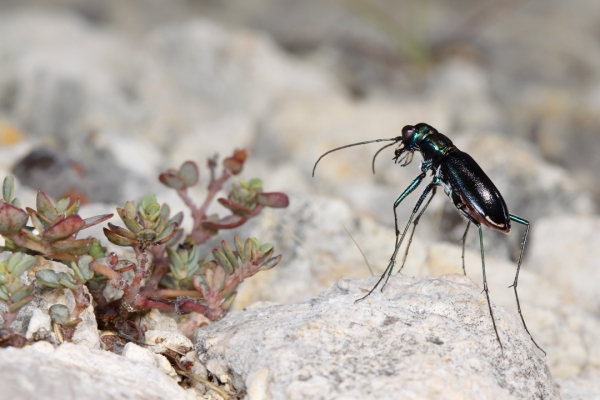During last week’s visit to Alabaster Caverns State Park in northeastern Oklahoma (Woodward Co.), I saw a fair number of jewel beetles (family Buprestidae) representing a then-unidentified species of Acmaeodera. All of the individuals that I saw were visiting flowers of Heterotheca stenophylla (family Asteraceae), and had it not been fall I wouldn’t have thought much about it. However, fall activity is unusual among North American jewel beetles, particularly in the genus Acmaeodera. An occasional straggler from earlier in the season is one thing, but the numbers seen (perhaps close to two dozen) over the course of a couple hours left no doubt in my mind that these were newly active adults. In North America, most species of Acmaeodera are active during the spring and early summer months, during which time they visit a wide variety of flowers (but especially asteraceous species) to feed on pollen. They can also be found in late summer in southeast Arizona, but in that area nearly all jewel beetles (and a large number of other insect groups as well) occur in synchrony with the monsoonal season that begins in July. Only in southern Texas (and further south in México) have I seen truly fall-active jewel beetles, including several species of Acmaeodera.
This actually was not the first time I had seen this species during fall in Oklahoma. Last year I made a brief stop at Gloss Mountain State Park (about 30 miles southeast of Alabaster Caverns in Major Co.) on my way back from a late September collecting trip to Colorado/Utah/Idaho (still convinced that the Beautiful Tiger Beetle, Cicindela pulchra, might be there). Then, as now, I found more than a handful of adults (also visiting flowers of H. stenophylla), suggesting this was true fall activity and causing me to think, “Hmm, that’s weird.” I was pressed for time, however, and didn’t even grab my camera bag for the short hour or so that I had to look around, and once I returned home I quickly resumed my routine and forgot about trying to identify the beetles.

Acmaeodera macra | Woodward Co., Oklahoma
Returning home after this year’s trip I was not so inclined to forget, and when I mentioned it to my friend Chuck Bellamy he suggested that it might be the fall-active species, Acmaeodera macra (MCZ type specimen). Immediately I knew this was correct, as I had actually seen this species once before—a single specimen that I collected nearly 30 years ago in south Texas at Bentsen-Rio Grandy Valley State Park on a Helianthus annuus flower (MacRae 2006). I don’t know why I didn’t think of that species when I saw it this time, other than perhaps I was still under the impression that this uncommonly encountered species was limited to the Rio Grande Valley and adjacent areas as stated by Vogt (1949) and Westcott et al. (1979). Recently, however, Westcott (2001) provided the first records of this species from outside of Texas—from Oklahoma!—and later recorded it also from Nuevo León, México (Westcott 2008).¹
¹ Nelson et al. (2008), in their North American catalogue of Buprestidae, also list Arizona in the distribution of this species. However, I am unaware of any supporting references for its occurrence there, and the catalogue is known to be frustratingly rife with errors and omissions.

Bathed in pollen!
The Oklahoma records for this species given by Westcott (2001) include localities in Blaine, Cleveland, Greer, and Oklahoma Counties (with the latter taken on Grindelia sp., presumably flowers). Interestingly, with the exception of Greer Co. all of these counties lie along the Blaine Escarpment that separates the Gypsum Hills and Red Hills physiographic regions, and the two additional counties that I have now recorded for the species in Oklahoma (Major and Woodward) lie further to the north along this escarpment as well. With these new records, Alabaster Caverns now becomes the northernmost known outpost for A. macra. However, since Woodward Co. lies along the northern tier of counties in Oklahoma and the Blaine Escarpment extends further into south-central Kansas, it is possible that an even more northern outpost might eventually be found for the species. Little is known about the biology of this species—the only host records are for adults and include my sunflower record (MacRae 2006), Vogt’s (1949) mention of the species’ preference for “composite flowers” and records of adults on Acacia berlandieri and visiting flowers of Verbesina encelioides (Westcott et al. 1979). It’s anybody’s guess as to what the larval host is, but my guess is that in Oklahoma it’s restricted to vertical walls and talus slopes, since I never saw individuals outside of these specific situations despite the widespread occurrence of its H. stenophylla flower host.
REFERENCES:
Nelson, G. H., G. C. Walters, Jr., R. D. Haines, & C. L. Bellamy. 2008. A Catalogue and Bibliography of the Buprestoidea of American North of Mexico. Coleopterists Society Special Publication No. 4, The Coleopterists Society, North Potomac, Maryland, 274 pp.
Vogt, G. H. 1949. A biologically annotated list of the Buprestidae of the Lower Rio Grande Valley, Texas. Annals of the Entomological Society of America 42(2): 192–202.
Westcott, R. L. 2001. An interspecific hybrid in the genus Acmaeodera Eschscholta, a taxonomic note on Chrysobothris kelloggi Knull, and new distribution and host records for United States and Canadian species in these and other genera (Coleoptera: Buprestidae). Jewel Beetles, 10:76-81.
Westcott, R. L., W. F. Barr, G. H. Nelson, & D. S. Verity. 1979. Distributional and biological notes notes on North and Central American species of Acmaeodera (Coleoptera: Buprestidae). The Coleopterists Bulletin, 33(2):169-181.
Copyright © Ted C. MacRae 2012



























